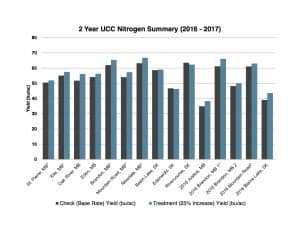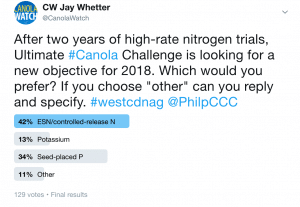Ultimate Canola Challenge 2017: Nitrogen results
UCC field-scale trials in 2016 and 2017 compared the farmer’s base nitrogen rate with a rate 25% higher. For example, if the farmer planned to use 100 lb./ac., the trial included replicated strips of 125 lb./ac.
Over the two years, 15 site-years were harvested and met protocol standards.
Results:
–With all site years averaged, adding extra nitrogen did provide a statistically significant yield response. Overall, yield did go up.
–Some sites showed a non-significant yield difference.
–Even with a yield increase, the increased nitrogen did not always provide an economic return when compared to the base rate.

For background numbers for this table and more UCC results: UCC results poster
Comments:
–Making decisions off one site or one year will not give a good idea of product performance over a range of conditions and environments. The variability inherent in field-scale trials means that making decisions based on one site or one year may compromise estimations of product performance over a range of conditions and environments.
Ultimate Canola Challenge 2018: The plan
@CanolaWatch ran a Twitter poll to test three ideas the UCC team had for 2018. The choices were: ESN/controlled-release N; potassium; seed-placed P; and “other”. With “other”, we did get some very good suggestions, but 42% of respondents chose the ESN/controlled-release N option and 34% chose seed-placed P. UCC will likely run with one or both of these trials for 2018. For more on UCC, go to ultimatecanolachallenge.ca. To participate in 2018, email Nicole Philp at philpn@canolacouncil.org.


